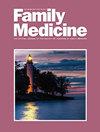Equity and Justice in Family Medicine Clinical Care and Teaching Must Incorporate a Reproductive Justice Framework
IF 1.8
4区 医学
Q2 MEDICINE, GENERAL & INTERNAL
引用次数: 0
Abstract
Since European settlement, the United States has controlled the reproduction of communities of color through tactics ranging from forced pregnancies, sterilizations, and abortions to immigration policies and policies that separate children from their families. Lesbian, gay, bisexual, transgender, queer (or questioning), asexual, intersex, and gender diverse people (LGBTQIA+) have been persecuted for sexual behavior and gender expression, and also restricted from having children. In response, women of color and LGBTQIA+ communities have organized for Reproductive Justice (RJ) and liberation. The Reproductive Justice framework, conceived in 1994 by the Women of African Descent for Reproductive Justice, addresses the reproductive health needs of Black women and communities from a broad human rights perspective. Since then, the framework has expanded with an intersectional approach to include all communities of color and LGBTQIA+ communities. Notwithstanding, reproductive injustice negatively impacts the health of already marginalized and oppressed communities, which is reflected in higher rates of maternal mortality, infant mortality, infertility, preterm births, and poorer health outcomes associated with race-based stress. While the impact of racial injustice on disparate health outcomes is increasingly addressed in family medicine, Reproductive Justice has not been universally incorporated into care provision or education. Including the RJ framework in family medicine education is critical to understanding how structural, economic, and political factors influence health outcomes to improve health care delivery from a justice and human rights perspective. This commentary describes how an RJ framework can enhance medical education and care provision, and subsequently identifies strategies for incorporating Reproductive Justice teaching into family medicine education.全科医学中的公平与正义 临床护理和教学必须纳入生殖正义框架
自欧洲人定居以来,美国一直通过各种手段控制有色人种的生育,包括强迫怀孕、绝育和堕胎,以及移民政策和将儿童与家人分离的政策。女同性恋、男同性恋、双性恋、跨性别者、同性恋者(或质疑者)、无性恋者、双性人和性别多元化者(LGBTQIA+)因性行为和性别表达而受到迫害,也被限制生育。为此,有色人种妇女和 LGBTQIA+ 社区组织起来,争取生殖正义(RJ)和解放。1994 年,"非洲裔妇女争取生殖正义 "组织提出了生殖正义框架,从广泛的人权角度解决黑人妇女和社区的生殖健康需求。尽管如此,生殖不公正对已经被边缘化和受压迫社区的健康产生了负面影响,这体现在较高的孕产妇死亡率、婴儿死亡率、不孕不育率、早产率以及与种族压力相关的较差的健康结果。虽然种族不公正对不同健康结果的影响越来越多地在家庭医学中得到关注,但生殖公正尚未被普遍纳入医疗服务或教育中。将生殖正义框架纳入家庭医学教育,对于了解结构、经济和政治因素如何影响健康结果,从而从正义和人权角度改善医疗服务至关重要。本评论描述了 RJ 框架如何能够加强医学教育和医疗服务的提供,并随后确定了将生殖正义教学纳入家庭医学教育的策略。
本文章由计算机程序翻译,如有差异,请以英文原文为准。
求助全文
约1分钟内获得全文
求助全文
来源期刊

Family Medicine
医学-医学:内科
CiteScore
2.40
自引率
21.10%
发文量
0
审稿时长
6-12 weeks
期刊介绍:
Family Medicine, the official journal of the Society of Teachers of Family Medicine, publishes original research, systematic reviews, narrative essays, and policy analyses relevant to the discipline of family medicine, particularly focusing on primary care medical education, health workforce policy, and health services research. Journal content is not limited to educational research from family medicine educators; and we welcome innovative, high-quality contributions from authors in a variety of specialties and academic fields.
 求助内容:
求助内容: 应助结果提醒方式:
应助结果提醒方式:


